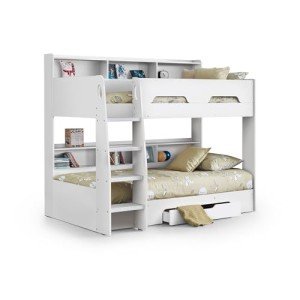20 Reasons Why Kids Bunk Bed Cannot Be Forgotten
The Ultimate Guide to Kids Bunk Beds: Maximizing Space and Fun
With the rise of vertical living and smaller spaces, the appeal of bunk beds has soared amongst families. Bunk beds not only offer a practical sleeping service, particularly in shared rooms, however they also bring a component of fun into a child's life. This thorough guide explores the functions, advantages, and factors to consider of kids' bunk beds, making it much easier for moms and dads to choose the ideal bed for their youngsters.
Features of Kids Bunk Beds
Bunk beds are flexible pieces of furniture that serve more than a single function. Here are some essential functions to consider:
Feature
Description
Product
Bunk beds can be built from wood, metal, or a combination of both, offering differing levels of toughness and design options.
Security Features
Many bunk beds come geared up with guardrails, safe and secure ladders, and capped supports for security, specifically crucial for young children.
Design Variety
Alternatives range from classic designs to modern designs, guaranteeing a match for any space design.
Space-Efficiency
Bunk beds use vertical space, making them ideal for smaller sized rooms.
Convertible Options
Some designs can be converted into two separate beds, offering versatility as children grow.
Storage Solutions
Some bunk beds include built-in storage drawers or racks, assisting to keep the room organized.
Advantages of Kids Bunk Beds
Investing in a bunk bed features numerous benefits:
- Space Saving: Bunk beds maximize floor space, enabling more play area or storage solutions.
- Enjoyable Factor: With a bunk bed, kids belong that promotes imagination and friendship during sleepovers or playdates.
- Economical: Instead of acquiring 2 separate beds, a bunk bed can accommodate 2 kids at when, saving cash in the long run.
- Adaptability: Many bunk beds can be dismantled or transformed into twin beds, making them a long-term investment as kids's requirements change.
- Social Interaction: Bunk beds encourage household bonding and relationships, supplying an inviting space for children to share stories and laughter.
Factors to consider When Choosing a Kids Bunk Bed
When selecting the perfect bunk bed for a kid, moms and dads need to consider different factors:
- Safety Standards: Ensure that the bunk bed abide by safety regulations and features essential security functions.
- Age Appropriateness: Different designs accommodate different age groups. For instance, traditional bunk beds may not appropriate for more youthful children.
- Space Dimensions: Measure the bedroom to ensure the bunk bed fits properly, enabling for space to move around easily.
- Weight Capacity: Consider the weight load of each bed and ensure it accommodates the child's weight easily.
- Design Preferences: Letting children participate in the choice process can assist them feel more thrilled about their brand-new bed.
Kinds Of Kids Bunk Beds
Bunk beds are available in different styles and configurations to suit numerous requirements:
Type
Description
Standard Bunk Bed
A classic style with one bed stacked on top of another, normally using a ladder to access the top bunk.
L-Shaped Bunk Bed
Features 2 bunk beds linked in an L-shape, often more roomy and ideal for kids sharing a room however needing a bit more space.
Triple Bunk Bed
Makes up three stacked beds, perfect for optimizing sleeping plans in really minimal areas.
Loft Bed
A raised bed with space underneath that can function as a backyard, study corner, or extra storage.
Futon Bunk Bed
Integrates a bunk bed on top with a futon or sofa underneath, making it great for pajama parties and taking full advantage of room use.
Convertible Bunk Bed
Can be separated into two private beds, using versatility as children's needs alter.
Taking Care Of Kids Bunk Beds
Maintaining bunk beds is essential for guaranteeing durability and safety. Here are some easy care practices:
- Regular Inspections: Check the bed frequently for loose screws and tightened bolts to ensure stability.
- Cleanliness: Keep bedding tidy and fresh, turning bed mattress for even use.
- Guardrails: Ensure guardrails are safe and in location, particularly if children tend to move around a lot in their sleep.
- Air Circulation: Ensure the bed has sufficient air flow, preventing moisture buildup that can cause mold or mildew.
FAQs About Kids Bunk Beds
Q1: At what age can a kid securely utilize a bunk bed?
A1: Generally, children aged six and older are considered safe to utilize the upper bunk due to the height and stability elements included.
Q2: Can I position a bunk bed near a window?
A2: It is a good idea to avoid placing a bunk bed near windows to lower the threat of falling or injuries.
Q3: Are bunk beds safe for younger kids?
A3: While some modern-day bunk beds come with safety functions accommodating more youthful kids, it is generally suggested to wait until they are older, generally over six years.
Q4: What is the typical weight limitation for leading bunks?
A4: Weight limits vary by model but usually range from 150 to 250 pounds. Constantly refer to the maker's specs.
Q5: How often should I check the bunk bed's security functions?
A5: It is advisable to perform a security check every couple of months or whenever you see any signs of wear.
Kids' bunk beds function as a tactical solution for households seeking to make the most of space while supplying a fun and interesting sleeping environment for their kids. With a range of options available— from standard designs to loft beds— parents have the liberty to choose something that meets their family's specific requirements. By thinking about just click the next web site as safety, space viability, and their children's choices, moms and dads can make an informed choice, guaranteeing that each child is thrilled about bedtime while benefiting from a well-organized space.
